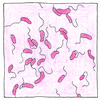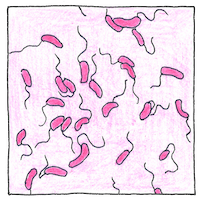Filippo Pacini,
Robert Koch
bacteriology

|
Vibrio cholerae
During the third cholera pandemic as cholera swept through Florence, scientists thought cholera wasn’t contagious or it was communicated by miasmas but Filippo Pacini did autopsies on cholera victims and found under the microscope from the inner layer of their intestines a comma-shaped bacillus, which he called vibrio. * Thirty years later, working in Egypt and India during the fifth cholera pandemic and unaware of Pacini’s work, Robert Koch found the same comma-shaped bacillus and managed to grow it in culture; however, his guinea pigs were immune to it. Nevertheless, Koch saw that the bacillus died in dry conditions and it died when exposed to weak acid solutions, so that Koch was able to formulate rules for the control of cholera epidemics.
Pandemics
In the first cholera pandemic hundreds of thousands of people died from the Ganges delta throughout Asia. In the second cholera pandemic from India both east to China and Japan and west to England. One hundred thousand died in Russia; twenty thousand died in Paris and another eighty thousand died in the rest of France; sixty-five-hundred thirty-six died in London. It jumped to Canada and New York, to the Pacific coast and Mexico. In the third cholera pandemic up to two hundred thousand died in Tokyo, more than a million died in Russia, twenty-three thousand died in England. and thirty-five hundred died in Chicago. During this pandemic, in 1854, Filippo Pacini identified vibrio cholerae as the cause of the disease. and John Snow identified a source of the disease, a well in the Soho area in London, and had the handle of the pump removed. In the fourth cholera pandemic one hundred and sixty-five thousand died in the Austrian Empire; seventy thousand died in Zanzibar; eighty thousand died in Algeria; thirty thousand died in Hungary; thirty thousand died in Belgium; twenty thousand died in Holland; one hundred thirteen thousand died in Italy; fifty thousand died in North America. In the fifth cholera pandemic ninety thousand died in Japan; sixty thousand died in Persia; more than fifty-eight thousand died in Egypt; two-hundred-sixty-seven thousand died in Russia; two-hundred-fifty thousand died in Europe; and fifty thousand died in the Americas. During this pandemic, Robert Koch explained how vibrio cholerae caused the disease. In the sixth cholera pandemic eight-hundred thousand died in India; two-hundred thousand died in the Philippines; five-hundred thousand died in Russia. The seventh cholera pandemic began in Indonesia and travelled through Pakistan, India, the Soviet Union, North Africa, and Italy. Over five-hundred-seventy thousand died worldwide.
The Wandering Jew
The wandering Jew, a symbol of the cholera in Eugène Sue’s novel, is not the villain of this story. The villains are the Jesuits, who poison, emprison, and murder to steal a family’s fortune.
Catching
Some say it isn’t catching; some say it is. Say whatever you like, we don’t experiment on humans and guinea pigs model humans in only basic mammalian ways. Determining efficacy often depends only on trial and error.



In Italy, people blamed the Jews and gypsies for bringing cholera; in Tunisia, people blamed Europeans; in the United States, people blamed the Southern blacks. In any place and any time, blame coexists with ignorance. Cholera causes fifty-eight thousand to one-hundred-thirty thousand deaths a year as of 2010.
See also in The book of science:
Readings in wikipedia: